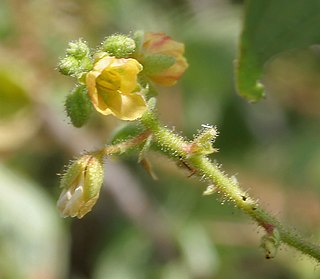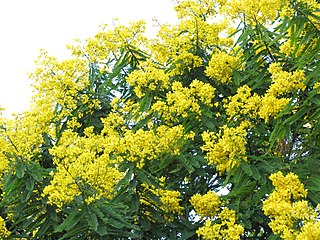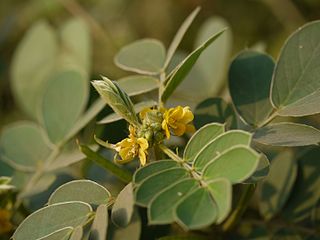
Cassia is a genus of flowering plants in the legume family, Fabaceae, and the subfamily Caesalpinioideae. Species are known commonly as cassias. The genus includes 37 species and has a pantropical distribution. Species of the genera Senna and Chamaecrista were previously included in Cassia. Cassia now generally includes the largest species of the legume subtribe Cassiinae, usually mid-sized to tall trees.

Senna spectabilis is a plant species of the legume family (Fabaceae) in the subfamily Caesalpinioideae native to South and Central America. They are often grown as an ornamental in front yards, parks, gardens, buildings etc. due to their bright yellow flowers that bloom during the summer months. They are also known as golden wonder tree, American cassia, popcorn tree, Cassia excelsa, golden shower tree or Archibald's cassia.

Senna obtusifolia, known by the common names Chinese senna, American sicklepod, sicklepod, etc., is a plant in the genus Senna, sometimes separated in the monotypic genus Diallobus. It grows wild in North, Central, and South America, Asia, Africa, and Oceania, and is considered a particularly serious weed in many places. It has a long-standing history of confusion with Senna tora and that taxon in many sources actually refers to the present species.

Senna, the sennas, is a large genus of flowering plants in the legume family. This diverse genus is native throughout the tropics, with a small number of species in temperate regions. The number of species is estimated to be from about 260 to 350. The type species for the genus is Senna alexandrina. About 50 species of Senna are known in cultivation.

Senna alexandrina is an ornamental plant in the genus Senna. It is used in herbalism. It grows natively in upper Egypt, especially in the Nubian region, and near Khartoum (Sudan), where it is cultivated commercially. It is also grown elsewhere, notably in India and Somalia.

Chamaecrista is a genus of flowering plants in the pea family, Fabaceae, subfamily Caesalpinioideae. Members of the genus are commonly known as sensitive pea. Several species are capable of rapid plant movement. Unlike the related genera Cassia and Senna, members of Chamaecrista form root nodules.

Senna wislizeni, commonly called Wislizenus' senna or shrubby senna. Formerly in the "wastebin taxon" Cassia sensu lato, it is now placed in the genus Senna or sometimes separated in Palmerocassia together with Senna unijuga.

Senna siamea, also known as Siamese cassia, kassod tree, cassod tree and cassia tree, is a legume in the subfamily Caesalpinioideae. It is native to South and Southeast Asia, although its exact origin is unknown.
Senna obliqua is a species of flowering plants in the legume family Fabaceae, and the subfamily Caesalpinioideae. It is found in Peru.

Senna surattensis is a plant species of the legume family (Fabaceae) in the subfamily Caesalpinioideae.

Senna pendula, also known as Easter Cassia, Christmas Senna, winter Senna, climbing Cassia, golden shower, pendant Senna and valamuerto, is a plant of the Fabaceae family with a shrub habit that is native to South America. It used in various parts of the world as an ornamental plant and is an environmental weed in Australia. The flowers are yellow and the name pendula means 'pendulous' or 'drooping'.

Chamaecrista absus, the pig's senna or tropical sensitive pea, is a species of flowering plant in the family Fabaceae, with a worldwide distribution in the tropics and subtropics. An annual herb reaching 60 cm (24 in), it is a common weed of cultivated and waste places, and its seeds are regularly harvested and sold for use in traditional medicine in Africa and Asia.

Senna multijuga, commonly known as November shower or false sicklepod, is a species of flowering plant in the family Fabaceae. It is native to wet tropical areas of Latin America, and widely introduced to other tropical locales such as Africa, India, Indonesia, China, Australia, and Hawaii. A fast-growing tree typically 10 m (33 ft) tall, it is planted in restoration projects, as an ornamental, and as a street tree, being especially useful under power lines.

Senna lindheimeriana, the velvet leaf senna, is a species of flowering plant in the family Fabaceae. It is native to the US states of Arizona, New Mexico, and Texas, and to eastern Mexico. A perennial typically 1.5 m (5 ft) tall, it is hardy to USDA zone 8a, and is recommended for xeriscaping and for feeding birds, butterflies and bumblebees. It is thought to be lethally toxic to livestock, but is so foul-smelling and unpalatable that only starving mammals will consume it.

Senna roemeriana, the twoleaf senna, is a species of flowering plant in the family Fabaceae, native to the US states of New Mexico and Texas, and to northern Mexico. A perennial of limestone soils and typically 18 in (46 cm) tall, it is toxic to livestock, particularly goats and sheep, but they avoid consuming it with proper range management.
Senna bauhinioides, the twinleaf senna, is a species of flowering plant in the family Fabaceae. It is native to the US states of Arizona, New Mexico, and Texas, and to northern Mexico, and it has been introduced to the US state of Maryland. An opportunistic species, it is unpalatable to livestock, so its presence is considered an indicator of overgrazing.
Senna atomaria, the flor de San Jose, is a species of flowering plant in the family Fabaceae, native to Mexico, Central America, the Caribbean, Colombia, and Venezuela. A shrub or small tree, it is considered a multi-purpose species; fuel, wood, biomass, soil improvement, medicine, and ornament.

Senna uniflora, the oneleaf senna, is a species of flowering plant in the family Fabaceae. It is native to Mexico, Central America, the Caribbean, Colombia, Venezuela, and most of Brazil, and has been introduced to India, Mauritius, and Réunion. Although it is somewhat weedy and invasive, it is used to out-compete the pernicious weed Parthenium hysterophorus.

Senna hirsuta, commonly known as woolly senna, is a species of flowering plant in the family Fabaceae and is native to Central and South America, but is naturalised in many other countries. It is an erect or spreading shrub or herbaceous perennial with pinnate leaves, with two to six pairs of egg-shaped leaflets, and yellow flowers arranged in groups of two to six, with six fertile stamens and four staminodes in each flower.
















